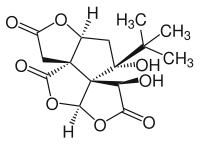All AbMole products are for research use only, cannot be used for human consumption.

Bilobalide is a compound with neuroprotective, antibacterial, and inhibitory effects.Bilobalide inhibits the hypoxia-induced reduction of ATP and under normoxic conditions increase glucose transport.Bilobalide is a inhibitor of GABA Receptor and SR.Bilobalide induced P19 cells differentiation into neurons in a concentration- and time-dependent manner.Bilobalide promoted neuronal differentiation through activation of Wnt/β-catenin signaling pathway. Exposure to bilobalide increased inactive GSK-3β phosphorylation, further induced the nuclear accumulation of β-catenin, and also up-regulated the expression of Wnt ligands Wnt1 and Wnt7a.Bilobalide significantly protected adipocytes from adverse effects of hypoxia in a dose-dependent manner by attenuating oxidative stress, inflammation and protecting mitochondria.The neuroprotective effects of bilobalide on cerebral I/R injury are associated with its inhibition of pro-inflammatory mediator production and down-regulation of JNK1/2 and p38 MAPK activation.
| Molecular Weight | 326.30 |
| Formula | C15H18O8 |
| CAS Number | 33570-04-6 |
| Solubility (25°C) | Ethanol 25mg/ml DMSO 25mg/ml |
| Storage |
Powder -20°C 3 years ; 4°C 2 years In solvent -80°C 6 months ; -20°C 1 month |
| Related GABA Receptor Products |
|---|
| β-CCB
β-CCB is a ligand for benzodiazepine receptor, which inhibits the binding of [3H]flunitrazepam and ethyl (3-[3H]carboline-3-carboxylate to benzodiazepine receptors, with Ki of 3-4 nM. |
| TPMPA
TPMPA, a hybrid of isoguvacine and 3-APMPA, is the first selective antagonist for a GABAC receptor (KB = 2.1 μM), but not to interact with GABAA (KB = 320 μM) or GABAB receptors (EC50 = 500 μM). |
| CI-966
CI-966 is a potent, selective, orally active and brain-penetrant inhibitor of the GABA transporter GAT-1, with IC50s of 0.26 μM and 1.2 μM for hGAT-1, rGAT-1, respectively. |
| NCS-382
NCS-382 is a potent GABA receptor antagonist and also a GHBR receptor antagonist. |
| CGS 8216
CGS 8216, a benzodiazepine receptor antagonist, inhibits 3H-flunitrazepam (3H-FLU) binding to rat synaptosomal membranes in vitro at subnanomolar concentrations. |
All AbMole products are for research use only, cannot be used for human consumption or veterinary use. We do not provide products or services to individuals. Please comply with the intended use and do not use AbMole products for any other purpose.


Products are for research use only. Not for human use. We do not sell to patients.
© Copyright 2010-2024 AbMole BioScience. All Rights Reserved.
